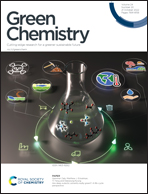Ecofriendly urea-free pretreatment to enhance the inkjet printing performance of reactive dye inks on cotton fabrics †
Abstract
In our work, a urea-free dye fixation process was developed to eliminate the use of urea and improve the dye fixation of reactive dyes to decrease the environmental influence of the inkjet printing industry. For this process, the effects of moisture content and 3-chloro-2-hydroxypropyltrimethylammonium chloride (CHPTAC) concentration on the inkjet printing performance were investigated. The ATR-FTIR results indicated that with the increase in the cotton fabric moisture content from 5% to 30%, the diffusion coefficient of the reactive dye increased from 1.65 × 10−6 cm2 s−1 to 1.66 × 10−5 cm2 s−1, contributing to the diffusion and fixation of reactive dyes on cotton fabrics. In addition, the simulation calculation results of Materials Studio showed that the moisture content of the fiber increased from 5% to 65%, and the volume of the cotton fiber model compound increased from 42 923 Å3 to 78 543 Å3, promoting the diffusion of the reactive dye on cotton fabrics. The competitive reaction was analyzed by ATR-FTIR, LC-MS and frontier molecular orbitals, indicating the suggested reaction mechanism in the urea-free dye fixation process. Compared with the conventional process, the urea-free dye fixation process not only obtained a good K/S value of 16.26 and dye fixation of 92.54% without urea but also decreased ammonia nitrogen content and COD in the wastewater, decreasing the ecological impact.



 Please wait while we load your content...
Please wait while we load your content...